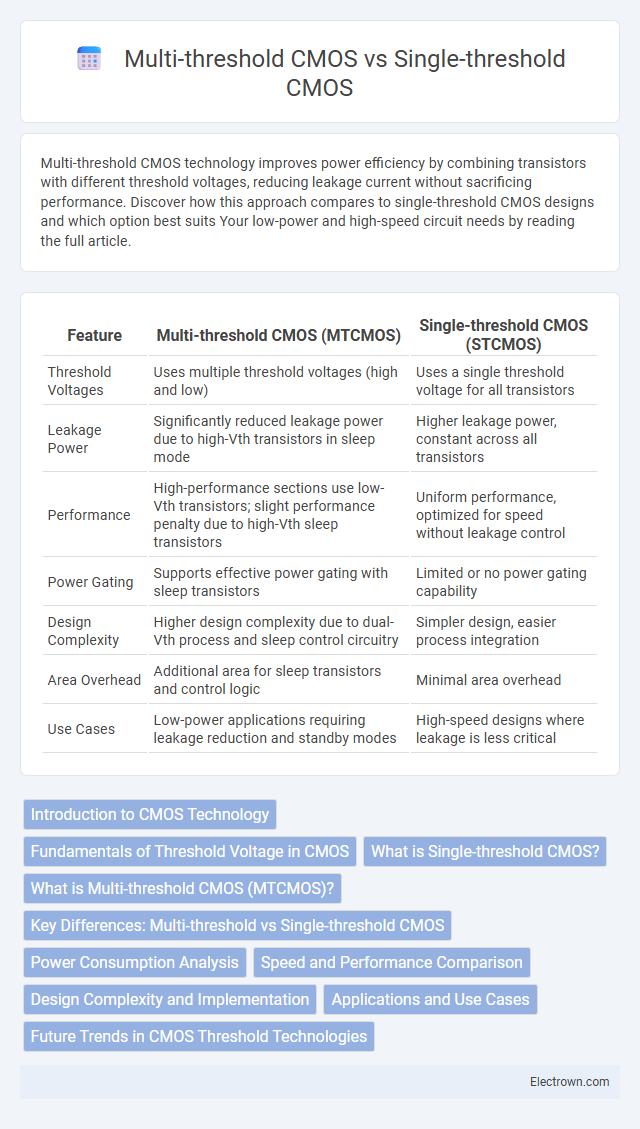Multi-threshold CMOS technology improves power efficiency by combining transistors with different threshold voltages, reducing leakage current without sacrificing performance. Discover how this approach compares to single-threshold CMOS designs and which option best suits Your low-power and high-speed circuit needs by reading the full article.
Table of Comparison
| Feature | Multi-threshold CMOS (MTCMOS) | Single-threshold CMOS (STCMOS) |
|---|---|---|
| Threshold Voltages | Uses multiple threshold voltages (high and low) | Uses a single threshold voltage for all transistors |
| Leakage Power | Significantly reduced leakage power due to high-Vth transistors in sleep mode | Higher leakage power, constant across all transistors |
| Performance | High-performance sections use low-Vth transistors; slight performance penalty due to high-Vth sleep transistors | Uniform performance, optimized for speed without leakage control |
| Power Gating | Supports effective power gating with sleep transistors | Limited or no power gating capability |
| Design Complexity | Higher design complexity due to dual-Vth process and sleep control circuitry | Simpler design, easier process integration |
| Area Overhead | Additional area for sleep transistors and control logic | Minimal area overhead |
| Use Cases | Low-power applications requiring leakage reduction and standby modes | High-speed designs where leakage is less critical |
Introduction to CMOS Technology
CMOS technology utilizes complementary pairs of p-type and n-type MOSFETs to achieve low power consumption and high noise immunity in integrated circuits. Single-threshold CMOS employs transistors with a uniform threshold voltage, balancing speed and leakage current for general applications. Multi-threshold CMOS integrates transistors with varying threshold voltages, optimizing power performance by reducing leakage in non-critical paths while maintaining speed in critical circuits.
Fundamentals of Threshold Voltage in CMOS
Threshold voltage (Vth) in CMOS technology determines the minimum gate-to-source voltage required to create a conductive channel between the source and drain terminals. Single-threshold CMOS uses one fixed threshold voltage for all transistors, balancing speed and power consumption but limiting flexibility in power-performance trade-offs. Multi-threshold CMOS incorporates transistors with varying threshold voltages, enabling optimized leakage current reduction and dynamic power management by selectively combining high-Vth and low-Vth devices within the same circuit.
What is Single-threshold CMOS?
Single-threshold CMOS technology utilizes a fixed threshold voltage (VT) for all transistors within a circuit, balancing power consumption and performance. This consistency helps maintain predictable switching characteristics but may lead to higher leakage currents compared to multi-threshold approaches. Understanding Single-threshold CMOS can help you optimize design choices for power-sensitive applications.
What is Multi-threshold CMOS (MTCMOS)?
Multi-threshold CMOS (MTCMOS) technology utilizes transistors with different threshold voltages within a single chip to optimize power consumption and performance. By integrating high-threshold devices to reduce leakage current during idle periods and low-threshold devices to maintain speed during active phases, MTCMOS effectively balances power efficiency and processing speed. Your designs benefit from significant energy savings without compromising computational capabilities, especially in low-power applications.
Key Differences: Multi-threshold vs Single-threshold CMOS
Multi-threshold CMOS employs transistors with varying threshold voltages to optimize power consumption and performance, enabling low-power modes and high-speed operation within a single circuit. Single-threshold CMOS uses uniform threshold voltages, resulting in simpler design but typically higher leakage current and less flexibility in power-performance trade-offs. Multi-threshold CMOS significantly reduces static power by selectively using high-threshold devices in non-critical paths, unlike single-threshold CMOS which lacks this granularity.
Power Consumption Analysis
Multi-threshold CMOS technology significantly reduces power consumption by using high-threshold transistors for leakage-sensitive paths and low-threshold transistors for performance-critical paths, optimizing static and dynamic power trade-offs. In contrast, single-threshold CMOS employs a uniform threshold voltage, resulting in higher leakage currents and increased standby power dissipation, especially in deep-submicron processes. Power analysis shows multi-threshold CMOS achieves up to 50% reduction in leakage power while maintaining performance, making it ideal for low-power and high-performance integrated circuits.
Speed and Performance Comparison
Multi-threshold CMOS technology enhances speed and performance by selectively using both high and low threshold voltage transistors, which reduces leakage current while maintaining fast switching speeds. Single-threshold CMOS relies on a uniform threshold voltage, often compromising either speed or power efficiency under varying conditions. Your circuit design can achieve optimized speed and power balance more effectively with multi-threshold CMOS due to its adaptable threshold voltages.
Design Complexity and Implementation
Multi-threshold CMOS technology increases design complexity due to the need for careful selection and integration of multiple threshold voltage transistors, which requires advanced process controls and more intricate layout strategies. Single-threshold CMOS offers simpler implementation with uniform transistor thresholds, reducing design time and minimizing variability but potentially sacrificing power-performance optimization. Your choice hinges on balancing the complexity of multi-threshold devices with the straightforwardness of single-threshold designs to meet specific power and speed requirements.
Applications and Use Cases
Multi-threshold CMOS technology excels in applications requiring a balanced trade-off between power consumption and performance, such as in low-power mobile devices and high-performance processors where leakage power reduction is critical. Single-threshold CMOS is commonly used in standard digital integrated circuits where uniform transistor thresholds simplify design, making it suitable for cost-sensitive and general-purpose applications. Your choice between multi-threshold and single-threshold CMOS depends on whether you prioritize power efficiency and speed or design simplicity and cost-effectiveness.
Future Trends in CMOS Threshold Technologies
Future trends in CMOS threshold technologies emphasize the integration of multi-threshold CMOS (MTCMOS) designs to optimize power efficiency and performance in next-generation chips. Research focuses on adaptive threshold voltage control to dynamically balance leakage current reduction and switching speed, surpassing the limitations of traditional single-threshold CMOS processes. Your applications will benefit from improved energy savings and enhanced reliability as semiconductor manufacturing advances incorporate these scalable threshold voltage solutions.
Multi-threshold CMOS vs Single-threshold CMOS Infographic

 electrown.com
electrown.com